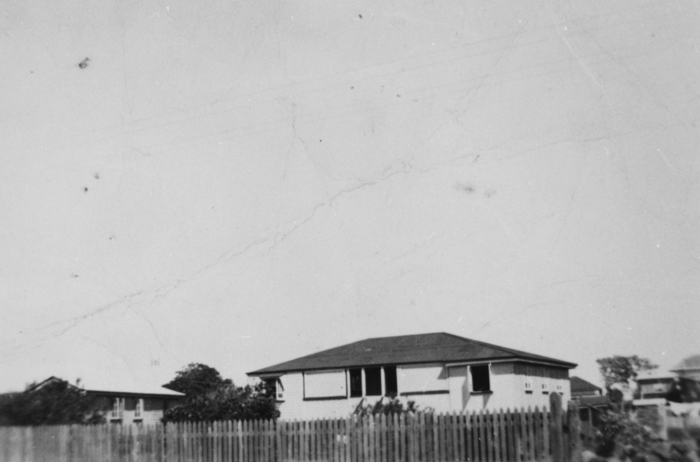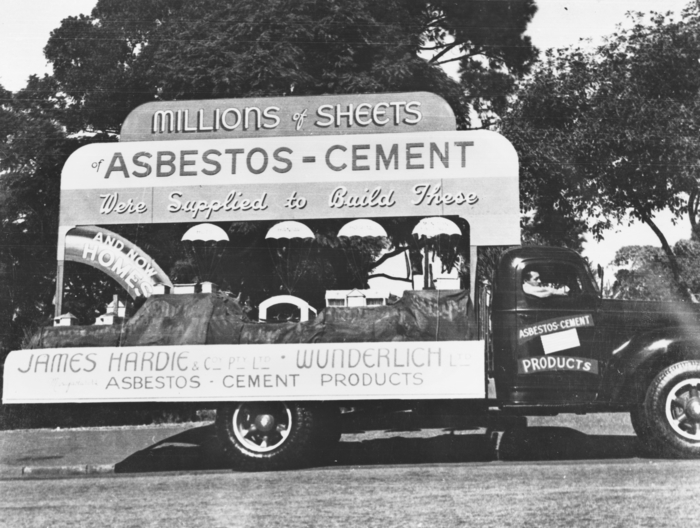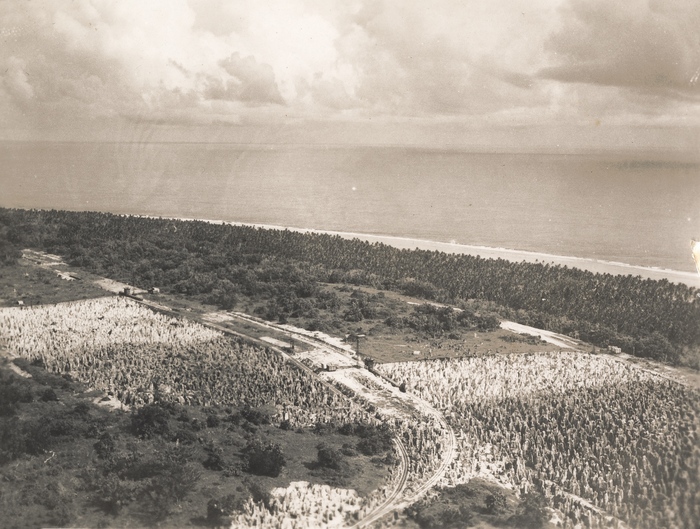Karma Eddison-Cogan and Fiona Allon
November 2019
In March 2019 the Australian Broadcasting Corporation (ABC) reported that refugees on Nauru may have been exposed to asbestos after materials containing the deadly substance had been packed in shipping containers and dumped metres away from the facility in which they were detained. This safety concern had been identified five months earlier by Canstruct, a Brisbane construction firm contracted to provide accommodation services to refugees and asylum seekers on Nauru. The firm had observed that the refugees in ‘Fly Camp’, unaware of the dangers of the materials, were using the asbestos-laden roofing and cladding to build sheds.1 There is a substantial quantity of asbestos on Nauru, largely within old and deteriorated housing and building materials. The small island became an offshore immigration detention facility and regional processing country in 2001 as part of the Australian government’s so-called ‘Pacific Solution’. Refugees and asylum seekers have been detained there in varying numbers, often for years, as they await processing and resettlement outside Australian borders.
Within Australia, asbestos is now considered a waste product and is heavily regulated as it is known to be a threat to human health. Correspondingly, the lives of asylum seekers arriving by boat are subject to the rigorous immigration policies of border control, strict media management, and mandatory detention. However, both the leaking of information about refugees on Nauru and the disclosure of the presence of asbestos on the island are not only failures of policy regimes to properly contain their ‘waste’ products. Both phenomena also signal that what is disposed of or relegated to the margins under conditions of putative invisibility does not simply disappear but instead has an uncanny capacity to return. This capacity indicates that waste is never a fixed or final state, frozen in space or time.
This essay traces a brief history of asbestos use in Australia and
the complicated history of the exploitation of raw materials on Nauru, including
the mining of phosphate in particular. We use the history of asbestos and
phosphate to explore the unruliness of such waste: its capacity to disturb
linear notions of time, to create volatile feedback loops between past and future
events, and to confound the notion of the future itself. The unpredictable temporalities of waste, which encompass the short-term effects of immediate toxicity and the long durée of epigenetic
change, complicate conventional understandings of time and duration. In this
instance, this includes the collision of asbestos and refugees on Nauru.
Disposing of Devil’s Dust
Asbestos is colloquially known as ‘devil’s dust’ and it is now widely acknowledged to be a deadly material. Australia began mining asbestos in the 1880s in Jones Creek, New South Wales. Asbestos cement was a common residential building material in Australia from the mid-1940s until the late 1980s. During the Australian housing boom in the 1940s, 1950s, and 1960s, one third of new homes were built with fibro made from asbestos. Inexpensive, durable, and adaptable, fibro was at the forefront of innovation in suburban housing design during this period. The ease of working with fibro facilitated the rise of owner-builders, and the material was used across a range of building types, from residential houses, to town halls, and churches. Until the mid-1980s, Australia was one of the highest per capita users of asbestos; almost every house that was built before 1985 contains asbestos. From the early 1970s, however, public warnings about exposure to the material gained traction along with knowledge of its cancer-causing properties. The manufacture and use of all types of asbestos was banned in Australia in 2003. In the state of New South Wales, asbestos management and removal is regulated by a number of government agencies and the material must only be disposed of at licensed landfill sites.

Within Australia, asbestos is heavily regulated to contain the risks associated with its use. But regardless of its regulation, asbestos cannot be straightforwardly contained. Despite the industry ban, exposure from home renovations in Australia remains a high risk simply because asbestos was so widely used as a building material in the construction of residential housing. Exposure to asbestos is causally linked to malignant mesothelioma, an aggressive cancer of the thin tissue that lines the lung, chest wall, and abdomen. Moreover, it is clear that materials such as asbestos do not disappear in the face of regulatory mechanisms, bans, and disposal; they can ‘transform, mutate, [and] morph’ based on their material states and their conjuncture with the human (Gregson et al. 2010, 1067). What asbestos can do, and how it can act upon the human, depends on its particular material and temporal states. In some forms it is a relatively stable, innocuous material but once disturbed it can have devastating effects. Through time, its dangers lie dormant until it is changed or transformed. Asbestos can travel in multiple directions, seeping through soils, carried on clothing, and lingering in unexpected ways beyond its initial use. These ongoing effects of asbestos are not immediate, but the capacity to imagine the long-term threat posed by exposure to such materials requires one to think of them not as discrete or ‘finished’ things but rather as already latent with the potential of possible futures. The Australian owner-builders who embraced asbestos cement sheeting (fibro) as the ‘wonderboard of the future’ and then developed asbestos-related diseases experienced a significant betrayal. Countless renovators whose investment of ‘sweat equity’ resulted in mesothelioma also experienced the disappearance of the futures they had been working towards.

Traces of the Past: Phosphate Mining on Nauru
Like the unanticipated consequences of asbestos use in Australia, the mining of phosphate on Nauru displays toxic traces of the past in the present. These traces illustrate the ongoing social, environmental, and economic effects of mining on the island, and also expose how the temporal rhythms of past phosphate exploitation remain inextricably entangled with political decision-making in the present and future. In the late 19th century, European demand for superphosphate as an agricultural fertiliser was rapidly increasing, and a worldwide search for sources of sulphate began. The mining of Nauru under the colonial rule of Germany commenced in 1906 when it was discovered that the small island had an abundance of high-quality phosphates. After World War One, the control of Nauru was passed on to the tripartite administration of the United Kingdom, Australia, and New Zealand. Under the Nauru Island Agreement of 1919, the three mandatory powers agreed among themselves that they alone would receive the phosphates of Nauru, and at cost price, with Nauruans receving a small fraction of the total value in royalties, calculated by the tons of phosphate exported. Australia benefited considerably from Nauru’s seemingly infinite reserves of superphosphate. A symbiotic relationship developed between the two countries with the mined phosphates converted into both industrial and domestic use fertilisers that were used across Australia, in agricultural production and in suburban backyards. Suburban expansion depended on this continuous supply of superphosphate. In this way, Nauru, a small island ostensibly marginal to Australian society became central to its national identity, wealth, infrastructure, and geopolitical future.

In the 1960s, after decades of mining had devastated the habitability and ecology of Nauru, transforming it into a ‘wasteland’ (‘Paradise Well and Truly Lost’ 2001), the Australian Government investigated the possibility of resettling Nauruans in Australia (Tabucanon and Opeskin 2011). Nauru, however, opposed the assimilationist policy proposed by Australia and sought to maintain its cultural identity within the legal form of sovereign nationhood. Australia’s plan was ultimately abandoned when Nauru became an independent nation in 1968. Widespread optimism and the promise of economic progress followed Nauru’s nationalisation of the phosphate mining industry and allowed it to significantly benefit from its own resources. In 1975, Nauru had the second-highest per capita income in the world. However, insufficient focus on long-term economic planning and skill building for the population, as well as environmental degradation resulting from decades of mining, wasteful expenditure, and the lack of an alternative economy to phosphate, eventually led to Nauru being characterised as a ‘failed state’ (Connell 2006).
By the beginning of the twenty-first century, phosphate deposits on Nauru had been exhausted, and the lack of viable economic alternatives led to the nation agreeing to Australia’s ‘Pacific Solution’ deal. In exchange for taking 310 asylum seekers who had been on board the Norwegian freighter MV Tampa and establishing a detention camp on the island, the Australian government pledged an initial twenty million dollars in development aid to Nauru. A co-dependent relationship was reinstituted between the two nations but on very different terms. In this new relationship, Nauru again provided the means by which the Australian centre retained its integrity and vigour, by removing the ‘boat people’ deemed to threaten its territorial sovereignty and nationalist identity to detention centres far away and hidden from sight. As one commentator put it, Nauru is now ‘Australia’s dumping ground for refugees’ (Doherty 2016). Unsurprisingly, Nauru itself has been characterised as a nation heading towards large-scale abandonment and, as John Connell (2006) observes, the future may see Nauruans seeking their own claims for economic refugee status.
Defying Spatio-temporal Logics
Australia’s current immigration policy, ‘Operation Sovereign Borders’, is characterised by a zero-tolerance approach to the arrival of asylum seekers by boat and includes their mandatory indefinite detention in offshore detention centres. Under the Australian Border Force Act 2015, any staff member within an offshore detention centre who makes an ‘unauthorised disclosure’ can be sentenced for up to two years in prison. Waste under the logics of modernisation, neoliberalism, and militarisation, as Henry Giroux (2006) writes, includes ‘no longer simply material goods but also human beings, particularly those rendered redundant in the new global economy’ (27). Like asbestos, the figure of the boat person is represented as waste, and one that poses a future threat that must be regulated and contained. The lives of asylum seekers and refugees in mandatory detention, suspended in an indeterminate and interminable state of confinement, belie modernist narratives of linear progression that cast human endeavour in terms of an arrow of time. Indeed, for those detained indefinitely or whose applications are rejected, the promise of a better future is not only suspended but put into reverse as they endure the uncertainties of resettlement and the possible return to dangerous former homelands.
Yet the leaking of information about refugees on Nauru and their potential exposure to asbestos indicates not only a failure to manage these material and human ‘risks to sovereignty’ (in both national and bodily senses) but the ways in which waste seemingly contained by assumptions about disposal and disappearance invariably returns to defy these spatio-temporal logics. Even when waste is physically absent or out of sight, it has the capacity to return and ‘act back’ (Gregson et al. 2007, 189). Journalistic reports on the lives of those detained on Nauru, as well as first-hand accounts told through social media and messaging applications, expose the ways that overlapping and contested narratives can haunt dominant notions of the present. Furthermore, the potential delayed effects of exposure to toxic materials for refugees on Nauru will appear at a future that is not yet conceivable under contemporary policy arrangements.
After decades of phosphate mining that served Australia’s suburban expansion, Nauru is now the location for detaining Australia’s unwanted arrivals. The potential futures of asbestos and of refugees and asylum seekers on Nauru are indeterminate. Both the deadly material and humans-deemed-waste are regulated, contained, and disposed of to restrict the threats they pose to the sovereignty of the body and of the nation. Asbestos in Australia had once been cast as the material that would accelerate the housing boom for decades to come. The mining of phosphate on Nauru had a similar promise, of economic prosperity for the future of the island. Both phenomena were premised on the linear and accelerated short-term temporalities borne of the mining industries. Presently cast aside in a conflation of material and human waste, the co-presence of asbestos materials and asylum seekers arriving by boat on Nauru is a stark reminder that, while it may be rendered invisible, waste, and the history of such waste, can reappear at the margins to defy a sense of spatial and temporal closure.
Works Cited
Connell, John. 2006, ‘Nauru: The First Failed Pacific State?’ The Round Table, 95 (383): 47—63.
Doherty, Ben. 2016, ‘A Short History of Nauru, Australia’s Dumping Ground for Refugees.’ The Guardian. 9 August.
Giroux, Henry. 2006. Stormy Weather: Katrina and the Politics of Disposability. Abingdon and New York: Paradigm Publishers.
Gregson, Nicky, Metcalfe, Alan, and Crewe, Louise. 2007. ‘Moving Things Along: The Conduits and Practices of Divestment in Consumption.’ Transactions of the Institute of British Geographers, 32 (2): 187—200.
Gregson, Nicky, Watkins, Helen, and Calestani, Melania. 2010. ‘Inextinguishable Fibres: Demolition and the Vital Materialisms of Asbestos.’ Environment and Planning A: Economy and Space, 42 (5): 1065—1083.
‘Paradise Well and Truly Lost.’ 2001. The Economist, 361 (8253): 39—41.
Tabucanon, Gil Marvel and Opeskin, Brian. 2011. ‘The Resettlement of Nauruans in Australia.’ The Journal of Pacific History, 46 (3): 337—356.
Notes
- The ABC report refers to the people living in Fly Camp as refugees as this is a settlement site that was established for individuals granted refugee status. Both asylum seekers and refugees are held on Nauru and this essay employs both terms where appropriate. ↑